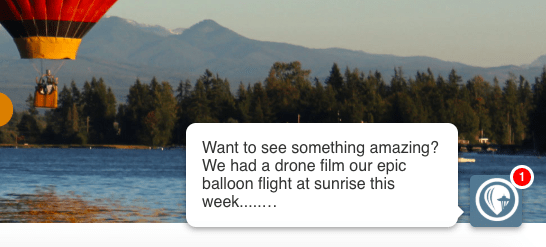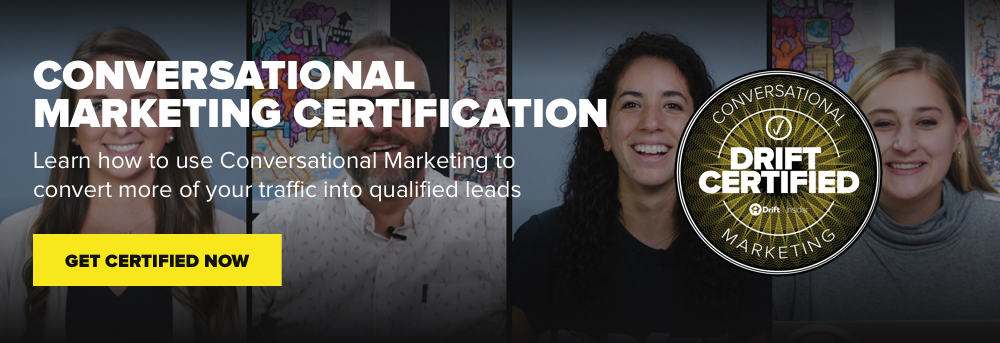
You’ve probably invested thousands of dollars into making sure your website user experience is just right. And you’ve added a chatbot on top of all that so you can automatically qualify your leads.
So why are so many people leaving your chat before they even begin?
Here’s the thing: your chatbot counts as UX, too.
That’s because if someone lands on your site and they have a poor chatbot experience, it doesn’t really matter how amazingly spectacular your product is.
All they see is a mediocre experience that makes it more difficult to get the answers they need.
Anyone can create an “okay” bot. At Ultra Cool, we specialize in building high performing Drift bots that take you from good to great. Named Drift’s Most Valuable Partner of the Year, we’ve had the fortune of working with a host of Drift customers. In doing so, we’ve noticed the same few mistakes keep popping up. Here’s what we’ve seen and our pro tips on how to course-correct ?
Mistake #1: You’re Missing A Contextual, Engaging Opener
Just like your subject line in an email, your opener is the prospect’s first impression of your bot. A generic “How can I help you?” message doesn’t offer any reason for them to click.
Are you just going to throw your hands up and say, “Well, we don’t know what to put there.” No!
How To Fix It: Write Like You Talk
If it’s something you can hear your sales team saying at a tradeshow or use as a killer subject line in your marketing emails, it’s probably a good fit to test your opening line.
A great opener is one that takes into account the context of the interactions you’ve already had with your customer. Instead of opening with an offer to book a demo or asking right away for an email, expand on a value statement or pique their curiosity about a pain point your product solves.
Here’s my secret opener: “Want to see something cool?”

Who doesn’t want to click on that?
Mistake #2: You’re Not Delivering Value On The Click
If you want to use my secret opener, then guess what: you have to show them something cool.
If you can’t give your customers or prospects something worthwhile, there’s no reason for them to click on it. Otherwise, they’ll leave your chat, and probably your website, too, since you didn’t do what you said you would.
How To Fix It: Build Your Bot Into Your UX
Your chatbot should deliver value every time. That requires careful planning around the full user experience they’re having with your brand.
It’s not just about first impressions, it’s about all the other visits after that.
So, think about your UX:
- Don’t have a bot fire right away on every single page. There’s all kinds of things you can do in Drift to set audience conditions and give buyers the right touch – you can change it to scroll percentage, for example, for top of funnel blog posts, so you’re not interrupting their reading experience.
- Customize your bot for each part of the sales cycle. If you send someone an email about a specific feature and they come to your site, you should talk to them about that specific feature, since that’s what they want to learn more about.
- Conceptualize your bot inside your existing UX. How do you want the experience to look? Do you want to have the bot fire right away from a specific link, or should it take 10 seconds, 30 seconds, or after they click on four different blog posts?
Mistake #3: You’re Not Answering The Right Questions
Context doesn’t mean asking question after question until your bot knows exactly what to say. Don’t make your customers work to buy from you. I’ve seen way too many bots offer multiple-choice answers and hoops for me to jump through when all I want to do is answer a specific question.
Typically, your customers or prospects have a few basic questions before booking a meeting or purchasing a product:
- How much is it?
- Does it integrate with my tech stack?
- What’s your company’s “why”?
- How does this help me?
- How quickly can I get started?
When you make it hard for them to learn the answers to those questions, it defeats the whole purpose of installing a chatbot in the first place. Each one of these questions implies a different level of intent. You should be able to answer each one of these, which you can do with…
How To Fix It: Keywords
A keyword is anything that a prospect can write into the chatbot that can trigger an answer. So when you think about keywords, they’re broken into three different categories:
- Similar keywords – identifies similar words or sentiment so you know how to respond. If you have one for “Hi,” it should recognize “Hey” and “hello” as greetings, for example.
- Contains keywords – when it “contains” that word. Here’s where it gets really fun, but it can also get awkward when used incorrectly. Take “cat” as a contains keyword. If your customer says “category,” and you give an answer about an animal, that doesn’t work. This should be a super-specific keyword you want it to contain, like “pricing” or a product name.
- Equals – looks for that exact phrase or keyword, something that is a one-word, to the point response. This is another type of keyword that will take time to refine. An example of this is the word “time.” It’s one of the most complicated keywords to use – someone can say “What time can we meet you?” or “How far ahead of time should we book?” and both of those mean very different things. We use a lot of exact keywords in that sense because we need to give specific answers.
Come up with the 10 most common questions that you get so you can have a bot answer it instead and a live person doesn’t have to spend time doing the same thing over and over again.
Mistake #4: You’ve Flubbed The Handoff
Bots usually have two buttons that people can use — one to go to a live chat person and one that’s more generic around value-proposition, like a video or a blog post.
But if they ask a high-intent question like, “How much does it cost?” it may not be routed to the right person, or they don’t respond right away, or it goes nowhere because it’s after-hours — why would they stick around for that experience?
If your sales team isn’t standing by ready to get to them within thirty seconds to have a conversation, you’re going to lose people. It’s the equivalent of calling and waiting on hold…which nobody wants to do.
How To Fix It: Optimize Your Sales Operations
One of the most successful ways we’ve used bots at Ultra Cool is by optimizing our sales operations flow. We’ve mapped out the right team – enterprise, account-based management, first available – for every possible query.
And if we’re not able to be on 24/7/365, we’ve spent time building a flow that can get them where they need to go – or at the very least, put together a snappy away message and a follow-up program in place so we’re not dropping any hot leads.
Mistake #5: You’re Overdoing It
Yes, I know you have goals. And big ones.
But if you come off too pushy too soon, all you’ll get is a big ‘ol exit. If you’re overselling via chat, they’ll never book a meeting because of a poor experience.
I’m also a hot air balloon pilot – it’s how I got into Drift in the first place. I was creating ads for the hot air balloon company to capture leads who had an anniversary coming up in the next 30 days.
So I spent a TON of money on a super contextual, really awesome ad that talks about their anniversary, that targets people who are having an anniversary, but my customers came onto the site and the bot just says, “Hi can I help you?” and jumps straight to booking a ride. That’s a huge turnoff.
How To Fix It: Pick Up The Conversation Where You Left Off
You have to know your customers and the context they need.
Your bot’s opener should say, in this case, “Congrats on your upcoming anniversary!” That’s not weird because there’s context — they’ve just clicked on an ad that has a similar message.
Rather than push your prospect away, you’re delivering value and continuing the conversation so they’re more likely to come back and engage with your brand.
Mistake #6: Your Bot Doesn’t Reflect Your Brand
There’s nothing quite so off-putting as a bland, generic bot that doesn’t match the rest of the site. Or worse, a conversation full of ridiculously cheeky emojis or GIFs when there’s not a single one to be found anywhere else on the site.
It comes off as inauthentic (and just plain weird).
How To Fix It: Brand Your Bot
Your bot is a mechanism to make your brand come to life, and express that very powerfully so that you can connect your customers and prospects.
How do you do this? We use a three-part formula over at Ultra Cool:
- Give your bot a personality. You want your bot to have a consistent personality that’s exhibited already in your brand. Adventurous, witty, wise – make it come to life by building your bot in a way that expresses it.
- Your bot should halo your brand. Dial up those personality traits – bots expect that they’re innovative and have some fun to dial up your personality in that bot
- Make sure it’s cohesive and contextual with their journey. This way you’re acknowledging where they’ve been and where they want to go. Meet them where they are so their brand experience is cohesive.
All three of those are a great way for your bot to express your brand and engage.
Want to chat more with Ultra Cool? They’ll be offering open office hours for the very first time on March 20th and 27th. Spots are limited to 10 people per session. You know what that means – the race is on. Ready…set…claim your spot here.
Conversational marketing makes it easier than ever before for marketers to start meaningful conversations with buyers. Visit Drift Insider to get certified in conversational marketing today.
Eliav is the Co-founder of Ultra Cool, a Drift agency whose only focus is helping companies build more effective Drift experiences. He has a vast sales and sales operations background and has been in over 40,000 face to face sales conversations. Eliav is the power user on the Drift platform and can be seen every morning from May-Sept flying his hot air balloon at sunrise in front of an active volcano in Seattle, Washington.






